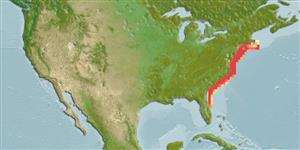Gastropoda |
Neogastropoda |
Melongenidae
Environment: milieu / climate zone / গভীরতার পরিসীমা / distribution range
বাস্তুসংস্থান
; ঈষৎ লোনা ; গভীরতার পরিসীমা 0 - 114 m (সূত্র 83435). Temperate; 42°N - 28°N, 81°W - 69°W (সূত্র 83435)
Western Atlantic and Eastern Central Pacific: USA; from Cape Cod, Massachusetts to Cape Canaveral Florida (Ref. 101514). Introduced to San Francisco Bay, CA. Subtropical to temperate.
Length at first maturity / আকৃতি / Weight / Age
পরিপক্কতা : Lm 15.5 range ? - ? cm Max length : 20.1 cm DL পুরুষ/ লিঙ্গ অনিধর্ারিত ; (সূত্র 83435)
Maximum depth from Ref. 104442. On intertidal flats and seaside lagoons (Ref. 104331). Inhabits sand and sand-mud bottoms, often entirely buried in sediments. Sometimes seen on mussel or oyster beds while foraging. Active at low light, mostly at night during summer months. Both an active predator and scavenger. Capable of readily detecting food in its vicinity (Ref. 101546) by sensing the water the prey pumps out (Ref. 105269). Primarily feeds on bivalves (Ref. 101546) such as mussels and oysters (Ref. 105269).
Life cycle and mating behavior
পরিপক্কতা | প্রজনন | ডিম ছাড়া | Eggs | ডিম্বধারন ক্ষমতা | Larvae
Copulation is evident. Life cycle: Embryos develop into planktonic trocophore larvae and later into juvenile veligers before becoming fully grown adults (Ref. 833).
Bisby, F.A., M.A. Ruggiero, K.L. Wilson, M. Cachuela-Palacio, S.W. Kimani, Y.R. Roskov, A. Soulier-Perkins and J. van Hertum 2005 Species 2000 & ITIS Catalogue of Life: 2005 Annual Checklist. CD-ROM; Species 2000: Reading, U.K. (সূত্র 19)
IUCN Red List Status
(সূত্র 130435: Version 2025-1)
CITES status (সূত্র 108899)
Not Evaluated
Not Evaluated
Threat to humans
Human uses
মৎস্য: বাণিজ্যিক
| FishSource |
হাতিয়ার
আরো তথ্য
Physiologyঅম্লজান ব্যবহার
Human RelatedStamps, coins, misc.
ইন্টারনেট সুত্র
Estimates based on models
Preferred temperature
(Ref.
115969): 8.5 - 24.6, mean 14.2 (based on 108 cells).
Fishing Vulnerability
Moderate to high vulnerability (54 of 100).
Price category
Unknown.
